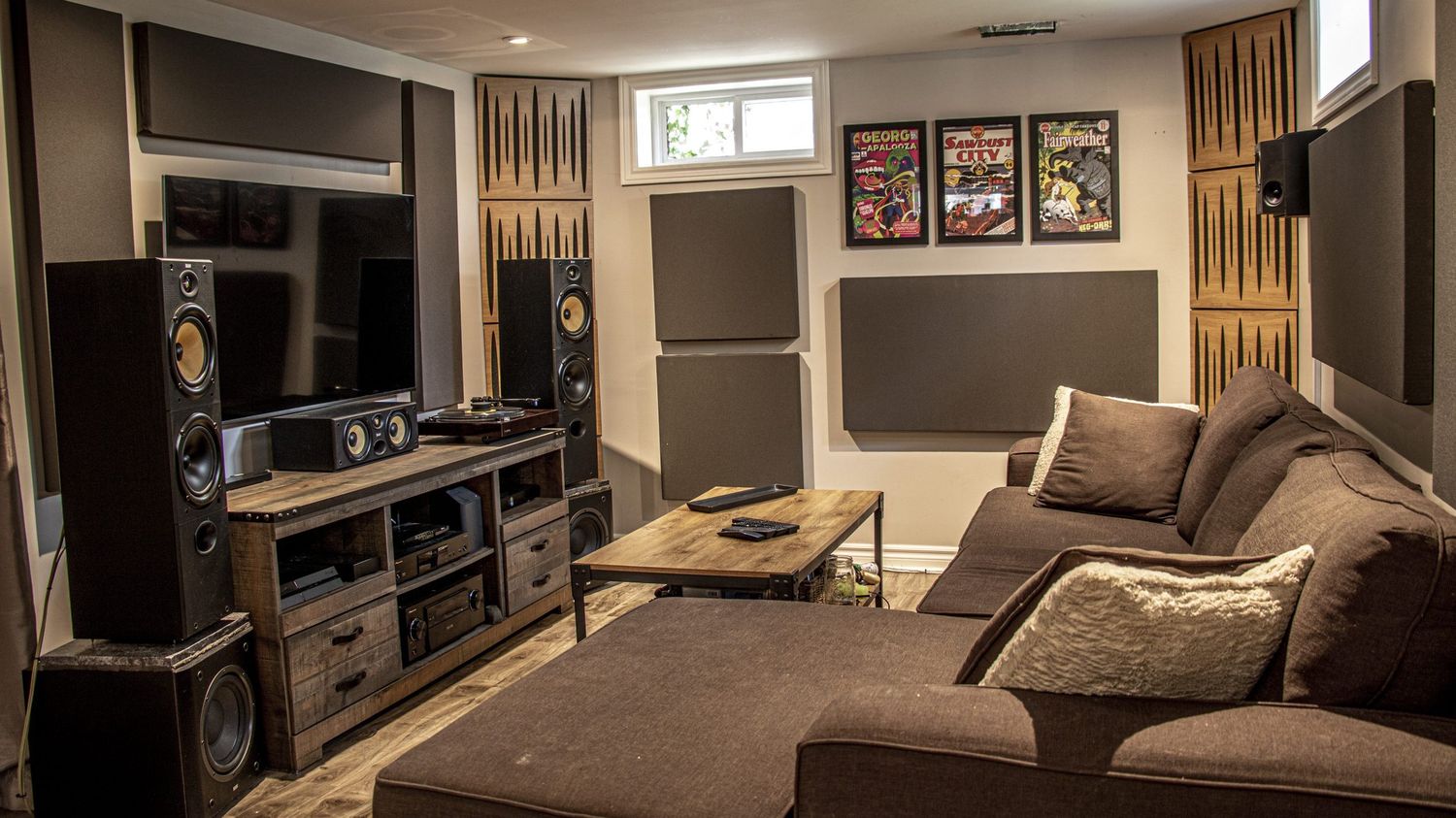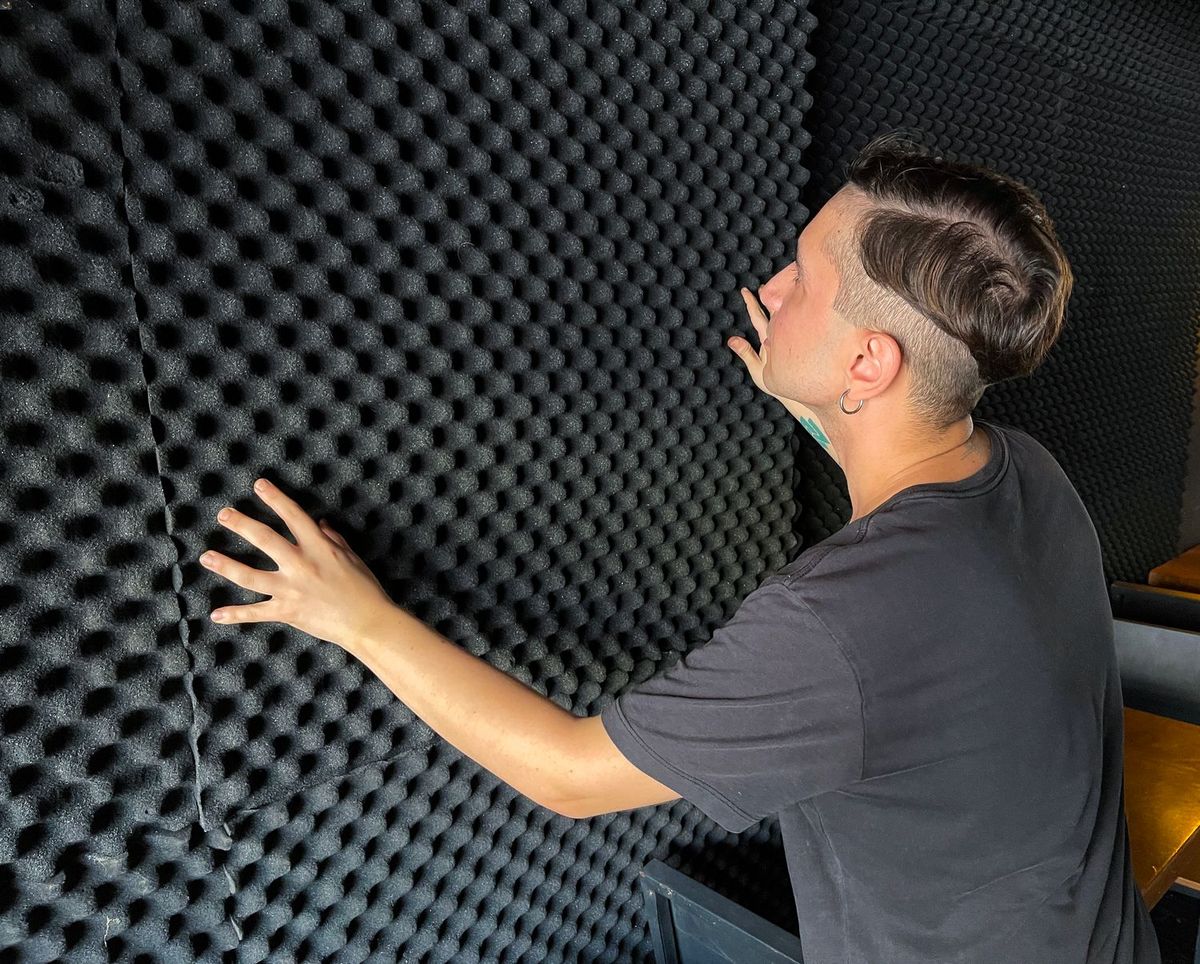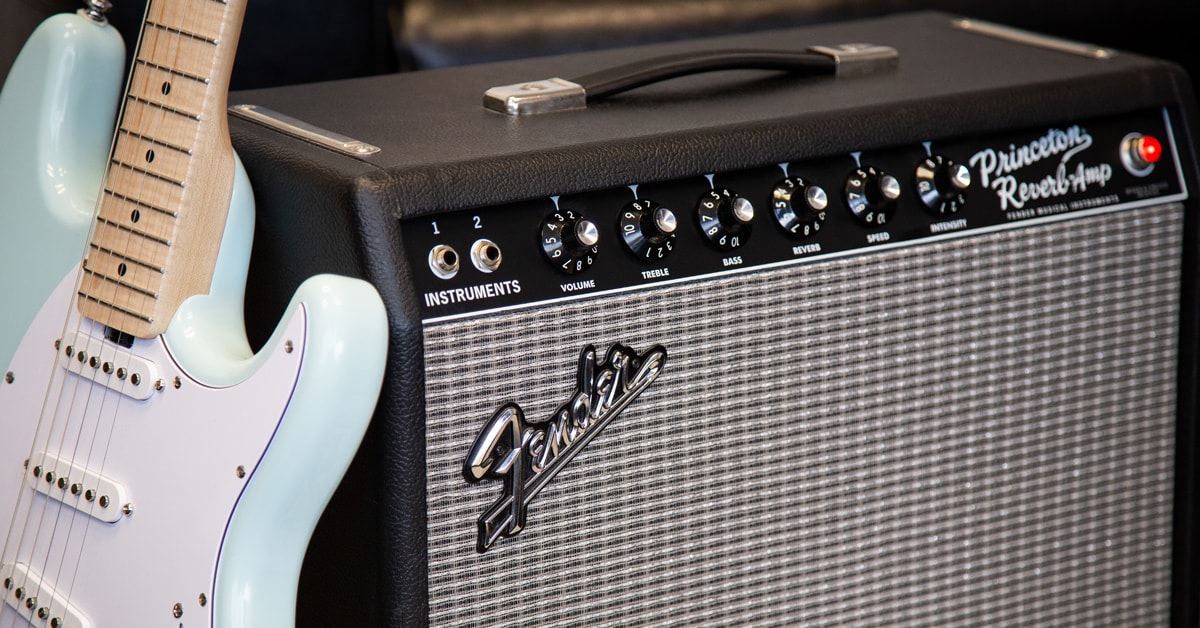Home>Production & Technology>Soundproofing>How Well Does Soundproofing Work


Soundproofing
How Well Does Soundproofing Work
Published: January 26, 2024
Discover how effective soundproofing can be in reducing noise levels and creating a peaceful environment. Explore different soundproofing techniques and products to enhance your living or working space.
(Many of the links in this article redirect to a specific reviewed product. Your purchase of these products through affiliate links helps to generate commission for AudioLover.com, at no extra cost. Learn more)
Table of Contents
Introduction
Soundproofing is a valuable solution for reducing unwanted noise and creating a peaceful environment. Whether you live in a noisy urban area, own a recording studio, or want to block out the noise from a neighboring apartment, soundproofing techniques can make a significant difference in your quality of life.
Understanding the basics of soundproofing is essential before diving into the various techniques and materials available. In this article, we will explore how soundproofing works, its effectiveness, and factors that can affect its efficiency. Additionally, we will debunk common myths surrounding soundproofing and provide insights into soundproofing for different environments.
So, if you’re tired of being disturbed by noise and seeking a way to bring tranquility to your space, buckle up and take a deep dive into the world of soundproofing. By the end of this article, you’ll be equipped with the knowledge to make informed decisions about soundproofing solutions.
Understanding Soundproofing
Before delving into the intricacies of soundproofing, it’s essential to grasp the concept of sound itself. Sound is essentially a form of energy that travels in waves and can be transmitted through various mediums, including air, water, and solids. It is created by vibrations that cause changes in atmospheric pressure.
The objective of soundproofing is to minimize the transfer of sound waves from one space to another or to absorb sound energy within a specific area. This is achieved by implementing techniques and using materials that prevent sound waves from passing through or bouncing off surfaces.
When sound waves encounter an object or surface, three things can happen: reflection, absorption, or transmission. Reflection occurs when sound waves bounce off a surface, like an echo in an empty room. Absorption refers to the process in which sound energy is absorbed by materials, reducing its presence in the room. Transmission is when sound waves pass through a surface, allowing noise to travel between spaces.
Soundproofing aims to minimize both transmission and reflection of sound waves. By utilizing soundproofing techniques and materials, such as insulation, mass-loaded vinyl, and acoustic panels, you can create a barrier that significantly reduces the amount of sound passing through or being reflected within a space.
It’s important to note that soundproofing is not about eliminating all sound. Rather, it is about reducing unwanted noise to a tolerable level, creating a comfortable and quieter environment.
Now that we have a basic understanding of soundproofing principles, let’s take a closer look at how it works and the various factors that impact its effectiveness.
How Does Soundproofing Work?
Soundproofing works by employing various techniques and materials to minimize the transmission of sound waves and reduce the impact of noise. These techniques aim to either block, absorb, or isolate sound energy to create a quieter environment.
One common method of soundproofing is introducing mass and density to barriers. Sound waves have a harder time passing through dense materials, such as concrete, brick, or heavy acoustic panels. These materials act as barriers, reducing the amount of sound that can enter or leave a space.
Another approach is to use insulation materials that can absorb sound energy. These materials, such as fiberglass, rock wool, or cellulose, trap sound waves and prevent them from bouncing back into the room. By absorbing sound rather than reflecting it, the overall noise level in the space is reduced.
Additionally, soundproofing can involve creating airtight seals to minimize sound leakage. Gaps, cracks, and openings allow sound to travel through walls and floors. By sealing these openings with materials like acoustic caulk or weatherstripping, the transmission of sound can be significantly reduced.
In some cases, soundproofing involves isolating the source of the noise. For example, in recording studios or home theaters, decoupling techniques are used to separate the room from external vibrations. This can be achieved by using resilient channels or sound isolation mounts to effectively isolate the space from surrounding structures.
It’s worth noting that no soundproofing method can completely eliminate all noise. Some level of sound will inevitably pass through. However, with the right combination of techniques and materials, a substantial reduction in noise can be achieved, resulting in a more peaceful and comfortable environment.
Now that we understand how soundproofing works, let’s explore the effectiveness of soundproofing in different scenarios.
The Effectiveness of Soundproofing
The effectiveness of soundproofing depends on several factors, including the techniques used, the materials employed, and the specific characteristics of the noise being targeted.
When it comes to soundproofing, the goal is not to completely eliminate all noise, but rather to reduce it to a more tolerable level. The effectiveness of soundproofing can vary depending on the type of noise you are trying to mitigate. For example, soundproofing may be highly effective in reducing airborne noise like traffic or loud conversations, but may be less effective in blocking lower frequency sounds like heavy machinery vibrations.
The construction and design of the building or space also play a significant role in determining soundproofing effectiveness. Buildings with thin walls, inadequate insulation, or multiple openings for sound to enter or escape will naturally have weaker soundproofing capabilities. In contrast, buildings with thicker walls, double-glazed windows, and proper insulation tend to be more effective at reducing noise transmission.
The quality and type of soundproofing materials used can greatly influence effectiveness. High-density materials such as mass-loaded vinyl or acoustic panels with sound-absorbing properties can significantly reduce noise levels. Similarly, employing techniques like decoupling or creating airtight seals can enhance the effectiveness of soundproofing measures.
It’s important to note that the effectiveness of soundproofing measures can also be influenced by personal expectations and preferences. What may be considered sufficient noise reduction for one person may not be enough for another.
Overall, while soundproofing can be highly effective in reducing unwanted noise, it is essential to manage your expectations and understand that complete elimination of all noise may not be possible in every scenario. However, with careful planning, proper design, and the right combination of techniques and materials, significant noise reduction can be achieved, creating a more peaceful and enjoyable environment.
Now that we understand the effectiveness of soundproofing, let’s delve into the various factors that can impact its efficiency.
Factors Affecting Soundproofing Efficiency
Several factors can influence the efficiency of soundproofing measures. Understanding these factors is crucial in determining the most effective strategies for noise reduction.
1. Construction and Materials: The construction of the building and the materials used play a significant role in soundproofing efficiency. Thick walls made of dense materials, such as concrete or brick, are more effective at blocking sound transmission compared to thin walls made of lightweight materials. Similarly, double-glazed windows or laminated glass can provide better insulation against external noise.
2. Air Gaps and Openings: Air gaps and openings in walls, floors, or windows can compromise the effectiveness of soundproofing. Even small gaps and cracks can allow sound to travel through. Sealing these gaps with acoustic caulk or weatherstripping can significantly improve soundproofing efficiency.
3. Mass and Density: The mass and density of materials used in soundproofing can affect its efficiency. High-density materials, such as mass-loaded vinyl or acoustic foam panels, are excellent at absorbing sound energy and reducing noise transmission.
4. Frequency of Noise: Different sound frequencies behave differently, and the effectiveness of soundproofing can vary. Low-frequency noises, like deep bass or vibrations, are generally harder to block compared to higher-frequency noises, like voices or music. Addressing low-frequency noises may require additional techniques, such as decoupling or adding mass.
5. Proper Installation: Soundproofing materials must be correctly installed to ensure maximum effectiveness. Improper installation can result in air gaps, compromised seals, or reduced performance. Consulting with an expert or following installation guidelines is crucial for optimal results.
6. Sound Reflection: When sound waves hit surfaces, they can reflect and bounce back into the room, contributing to noise pollution. Using sound-absorbing materials like acoustic panels or drapes can help minimize sound reflection and improve soundproofing efficiency.
7. Multiple Layers and Techniques: Combining different soundproofing techniques and materials can enhance effectiveness. Layering materials or using a combination of insulation, acoustic boards, and resilient channels can provide better noise reduction than relying on a single method.
8. Overall Noise Level: The magnitude of the noise you are trying to mitigate can impact the perceived efficiency of soundproofing. If the original noise level is extremely high, the reduction provided by soundproofing techniques may still result in a noticeable noise presence. However, soundproofing measures can still significantly improve the overall comfort and quality of the space.
By considering these factors and tailoring soundproofing strategies accordingly, you can optimize the efficiency of noise reduction and create a more peaceful environment.
Now that we understand the factors affecting soundproofing efficiency, let’s explore the various soundproofing techniques and materials available.
Soundproofing Techniques and Materials
There are various techniques and materials available for soundproofing, each designed to address specific noise-related challenges. Understanding these options will enable you to choose the most suitable approach for your specific needs:
1. Insulation: One of the most common and effective soundproofing techniques is installing insulation. Fiberglass, mineral wool, and cellulose insulation materials are excellent for absorbing sound energy and reducing noise transmission.
2. Mass-Loaded Vinyl (MLV): MLV is a dense, flexible material that acts as a barrier to sound. It can be installed on walls, ceilings, and floors to effectively block noise. MLV is particularly useful in reducing airborne noise like voices or traffic.
3. Acoustic Panels: These panels are designed to absorb and reduce sound reflections in a room. They are often made of dense foam or fabric-wrapped fiberglass and can be mounted on walls or ceilings. Acoustic panels are effective in controlling echoes and improving sound quality.
4. Resilient Channels: These metal channels are used to decouple walls or ceilings from the surrounding structure, preventing vibrations and reducing noise transfer. Resilient channels are commonly used in recording studios or home theaters to minimize structural and airborne noise.
5. Soundproof Curtains: These heavy-duty curtains are made with multiple layers of dense fabric or soundproofing materials. They can block outside noise and reduce sound reflections within a room. Soundproof curtains are a convenient and affordable option for controlling noise in residential spaces.
6. Soundproof Doors and Windows: Upgrading to doors and windows with soundproofing features, such as double or laminated glass, can significantly reduce external noise transmission. Sealing gaps around doors and windows with weatherstripping or acoustic caulk further improves their soundproofing capabilities.
7. Soundproof Foam: Made from sound-absorbing foam materials, these panels are commonly used in recording studios, home theaters, and music practice rooms. Soundproof foam panels can reduce echoes and reverberations by absorbing sound waves.
8. Soundproof Fences and Barriers: These specialized fences or barriers are designed to reduce noise pollution from traffic, neighbors, or industrial areas. They are typically constructed using dense materials or a combination of mass and sound-absorbing elements.
When implementing soundproofing techniques, it’s important to consider the specific requirements of your space and the type of noise you want to address. Combining multiple techniques and materials can often yield the best results in creating a quiet and peaceful environment.
As we continue our journey to better understand soundproofing, let’s debunk some common myths associated with this practice.
Common Myths About Soundproofing
Soundproofing is a widely discussed topic, but unfortunately, there are several misconceptions and myths surrounding it. Let’s debunk some of the most common myths about soundproofing:
1. Myth: Soundproofing can completely eliminate all noise.
Reality: While soundproofing can significantly reduce noise levels, it cannot eliminate all sound. It aims to create a quieter and more comfortable environment by minimizing noise transmission and reflection. Complete silence is not achievable, nor is it desirable in most cases.
2. Myth: Soundproofing materials are expensive and inaccessible.
Reality: While high-end soundproofing solutions can be costly, there are plenty of affordable options available. From DIY techniques like caulking gaps and using weatherstripping to budget-friendly materials like acoustic foam panels or curtains, there are soundproofing solutions for every budget.
3. Myth: Soundproofing only benefits those who live in noisy environments.
Reality: Soundproofing offers benefits to people in various situations. It can create a more peaceful and focused atmosphere in home offices, enhance privacy in shared living spaces, improve sound quality in recording studios, and provide a more comfortable environment for relaxation and sleep.
4. Myth: Soundproofing requires extensive renovations.
Reality: While some soundproofing techniques may involve minor renovations, such as adding insulation or installing resilient channels, not all soundproofing methods require significant changes to the structure. Simple solutions like using heavy curtains, acoustic panels, or soundproofing paint can make a noticeable difference in reducing noise levels.
5. Myth: Soundproofing is only for walls and ceilings.
Reality: While soundproofing walls and ceilings is often a primary focus, other areas also benefit from soundproofing. Doors and windows, for example, are common sources of noise transmission and can be effectively soundproofed using specialized materials like weatherstripping, double-glazed glass, or soundproofing curtains.
6. Myth: Soundproofing makes a room completely soundproof for both incoming and outgoing noise.
Reality: Soundproofing can greatly reduce both incoming and outgoing noise, but it may not eliminate all sound. Sound can still enter or leave through ventilation systems, gaps in doors or windows, or structural weaknesses. However, using multiple soundproofing techniques and addressing these potential leakage points can significantly improve the overall soundproofing performance.
By understanding the reality behind these common myths, you can make well-informed decisions when it comes to implementing soundproofing solutions for your space.
As we near the end of our exploration of soundproofing, let’s discuss how soundproofing can be tailored for different environments and purposes.
Soundproofing for Different Environments
Soundproofing techniques can be customized to suit various environments and purposes. Whether you’re looking to create a peaceful home, build a professional recording studio, or reduce noise in a commercial space, here are some considerations for different environments:
1. Residential Spaces: Homes can benefit from soundproofing to block out external noise, minimize noise transfer between rooms, and improve privacy. Effective solutions include insulating walls, floors, and ceilings with sound-absorbing materials, using soundproof curtains, upgrading doors and windows, and sealing gaps.
2. Home Offices: Soundproofing home offices helps reduce distractions and enhance concentration and productivity. Key soundproofing strategies include using acoustic panels on walls and ceilings, adding carpet or rugs to absorb footstep noise, and using soundproofing partitions to create a dedicated workspace.
3. Entertainment Areas: Whether it’s a home theater or a music room, soundproofing is crucial to create an immersive and enjoyable experience while minimizing noise leakage. Soundproofing options for entertainment areas include using acoustic panels on walls and ceilings, installing soundproof doors and windows, and considering decoupling techniques to reduce vibrations.
4. Commercial Spaces: Offices, restaurants, and retail spaces can benefit from soundproofing to create a comfortable environment for employees and customers. Utilizing materials like acoustic panels and sound-absorbing ceiling tiles can reduce noise levels, while soundproof partitions and carpeting can help control sound within specific areas.
5. Recording Studios: Soundproofing is essential in recording studios to achieve optimal sound isolation and prevent external noise contamination. Key techniques include building floating floors and walls to decouple the studio from the building structure, using soundproof doors and windows, and incorporating specialized acoustic treatment with bass traps and diffusion panels.
6. Educational Facilities: Schools, colleges, and libraries can employ soundproofing techniques to create quiet study areas, reduce noise between classrooms, and maintain a conducive learning environment. This may involve using sound-absorbing materials in ceilings and walls, installing soundproof doors, and implementing proper insulation to minimize noise transfer.
7. Hotels and Hospitality: Soundproofing is crucial in hotels to ensure guests have a peaceful and restful stay. Techniques such as using double or laminated windows, installing soundproof doors, and incorporating sound-absorbing materials in common areas can help reduce noise from outside and within the building.
It’s important to assess the unique noise challenges and requirements of each environment to implement the most effective soundproofing solutions. Consulting with professionals in the field can provide valuable insights and guidance tailored to your specific needs.
As we conclude this article, we hope you now have a comprehensive understanding of soundproofing and how it can enhance your living or working environment. With the right techniques and materials, you can create a peaceful and harmonious space, free from unwanted noise. So, go ahead and take the necessary steps to bring tranquility into your life.
Conclusion
Soundproofing is a valuable solution for reducing unwanted noise and creating a more tranquil environment in various settings. By understanding the principles of soundproofing and implementing the right techniques and materials, you can significantly minimize noise transmission and improve the overall quality of your space.
We’ve explored the fundamentals of soundproofing, including how it works, its effectiveness, and the factors that can impact its efficiency. We’ve debunked common myths surrounding soundproofing and discussed soundproofing techniques and materials for different environments.
From residential spaces to commercial establishments, soundproofing can provide numerous benefits, such as improved privacy, enhanced concentration, reduced noise pollution, and an overall greater sense of well-being. While complete silence may not be achievable, soundproofing can make a noticeable difference in creating a more peaceful and enjoyable environment.
Remember, soundproofing is a customizable process, and the choice of techniques and materials should be tailored to your specific needs and environment. It’s important to consider factors like construction, frequency of noise, and the desired level of noise reduction when implementing soundproofing measures.
Whether you’re looking to create a quiet home, a productive workspace, or a professional recording studio, exploring soundproofing options and consulting with professionals can help you achieve optimal results.
So, take control of your environment, reduce unwanted noise, and enhance your quality of life. With the right knowledge and approach, soundproofing can bring peace and tranquility to your space, allowing you to fully enjoy the moments that matter most.











